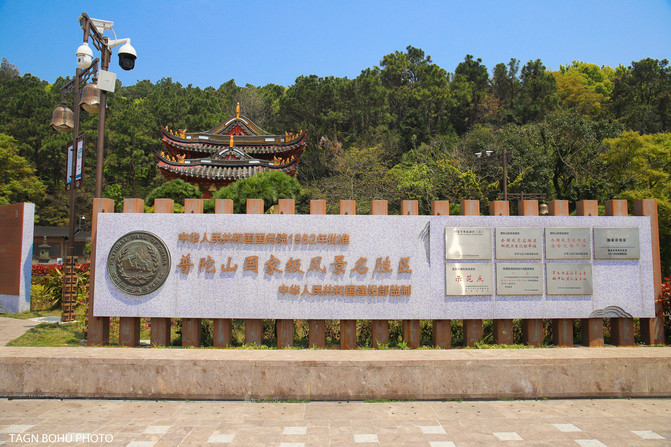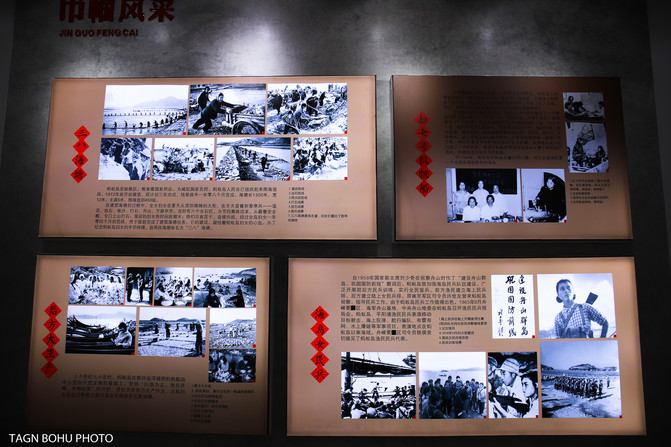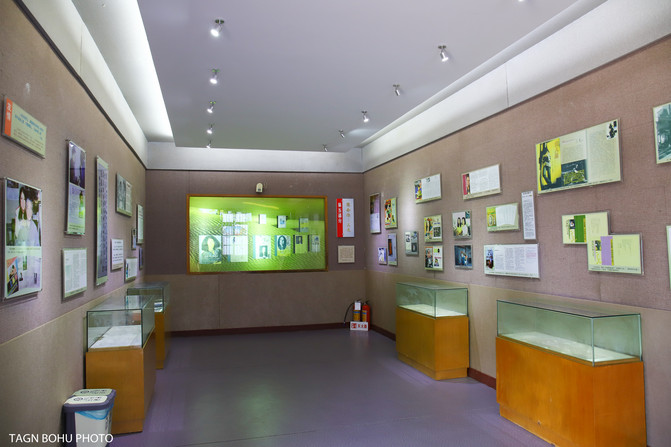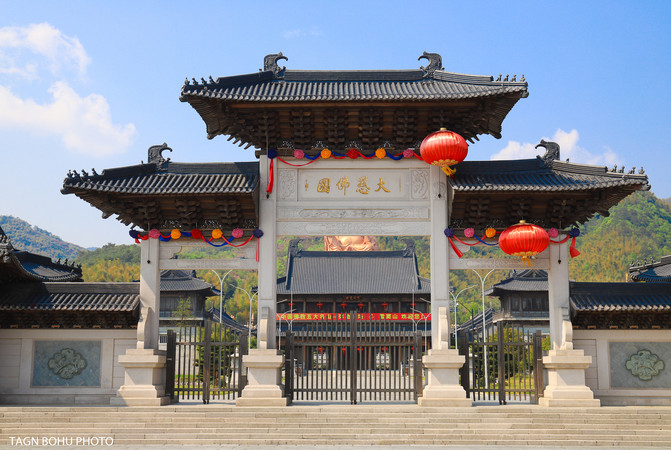Click on the niche route of Zhoushan and enjoy the quiet coastal town with blue sea and blue sky
preambular
When people talk about Zhoushan, they think of Mount Putuo most. Mount Putuo is one of the four famous mountains of Buddhism in China and the dojo where Guanyin Bodhisattva cultivates all living beings. The scenic scenery of Putuo Mountain integrates temples, sea, gold sand and strange rocks. Climbing a range rover and overlooking the blue sea, you can see thousands of miles away, and you can see the boundless sea and sky. The trees on the island are green, birds sing and fragrant, and lush. Walking on Ant Island blowing the salty sea breeze is like coming to a paradise outside the world. This is the country's first people's commune. The people here once created a new world through hard work.



The country's first people's commune was on Ants in Zhoushan. Zhou felt the spirit of hard work in those days on Ant Island.

Zhoushan Dinghai Xiaosha Tourist Area is an original tourist check-in place with an pastoral style. It is the hometown of the famous writer San Mao.


Mount Putuo, one of the four most famous Buddhist mountains in China
I came to Zhujiajian Wudongzhi Wharf early in the morning and took a boat to Putuo Mountain. There weren't many people before May Day. You can book the ferry ticket and ticket together online in advance, and just swipe your ID card live on the boat. Putuo Mountain is surrounded by the sea on all sides, with archipelago lined with lush green peaks and a pleasant climate. It is surrounded by golden sand, surrounded by white waves, and fish sails are flying in competition. The silver golden sand surrounds a large number of ancient temples, Jingshe, temples, pavilions, cliff stone carvings, sculptures and cultural relics. The rich cultural landscape such as the golden sand, strange stones, tidal sounds, ancient caves and the sea, ancient and famous trees blend into each other and make people forget to leave.




Mount Putuo, the holy land of Guanyin, is one of the four famous Buddhist mountains in my country. It is equally famous as Wutai, Emei and Jiuhua, and has its unique charm with the style of a Buddhist country. Guanyin Dojo once had three major temples: Puji, Fayu and Huiji, eighty-eight nunnery, 128 Mao Peng, known as the 500 jungles, and 3,000 monks. There are more than 30 Buddhist temples dedicated to pilgrimage and sightseeing by all living beings. Nanhai Guanyin, Jiulong Hall, and Yangzhi Guanyin Monument are known as the Three Treasures of Mountain Town in the Buddhist Kingdom.



After getting off the boat, walk along the right hand side, or you can take a car on the island to various attractions. The cost to each attraction varies, and you can go to each attraction according to your hobbies. But I chose to walk. I wanted to check in every place in Putuo Mountain. So I walk slowly and don't miss every attraction. Walking on the road, the ubiquitous green plants make your eyes suddenly open. The green camphor tree has just been replaced with new leaves. The tender leaves are emerald green. Along the road to the top of the mountain, there is green everywhere. The scene is full of greenery.






Walking along the road towards the seaside, you will see the Nanhai Guanyin statue not far away. Hainan Guanyin stands on the mountain facing the South China Sea. Walking further up the mountain, you will encounter some kittens sleeping on the ground on the road. These cats are not afraid of people. I feel that if cats see too much, tourists are not afraid of giving birth. Walking further up the mountain and down the road, you will arrive at the entrance of Hainan Guanyin. Two lions are looking at the door. The first place they go after visiting Putuo Mountain is Hainan Guanyin. The most famous thing on the entire island is Guanhai Guanyin. Come here first and pay a visit and then go to various attractions. This way, the tour route will be better.




From the other side, you can see that Nanhai Guanyin seems to be floating in the woods. Whenever there is fog in the morning, this place becomes a fairyland. There are also several temples on the left side of the entrance of Hainan Guanyin Gate. You can go and have a look below. It is surrounded by the sea, and the sea breeze is blowing. I heard that it is very accurate to pay homage to Nanhai Guanyin piously.


Putuo Temple. When going to Putuo Mountain, the first thing to go to is Putuo Zen Temple. There are 357 halls and pavilions in the temple, and the Dayuan Hall is the main hall of the entire temple, also known as the "Living Hall". You can pray for Buddha here, face Guanyin Bodhisattva piously, seek happiness and marriage for yourself, and seek peace and health for your family. After paying homage to Nanhai Guanyin, I came to the Putuo Mountain Buddhist Museum. There is a thousand-year-old stupa inside. The ancient stupa attracts many tourists to come and see. There are many Buddhas carved on the stupa. As time goes by, the Buddha carvings on the stupa are still visible.


There is a stone pagoda next to Puji Temple-Duo Pagoda, which is the oldest building in Puji Temple. Although it is impossible to see it up close because of the courtyard wall, it is one of the three treasures of Putuo.


Puji Temple, also known as Qiansi, is the oldest temple in Mount Putuo
Puji Temple, also known as Qiansi, is the oldest temple in Putuo Mountain and the largest temple in Putuo Mountain. All major Buddhist and Shun activities are held here. The entire temple is built on a relatively wide and flat mountain area. The water in front of the temple is accumulated by mountain springs. The pool is full of lotus seeds. In summer, the fragrance of lotus flowers strikes people, which is the night moon of the twelve scenic lotus ponds in Putuo.






There are three temples, three treasures, three stones and three caves in Puji Temple, namely Puji Temple, Fayu Temple, Huiji Temple, Duo Pagoda, Yangzhi Guanyin Monument, Jiulong Caizhou, Pantuo Stone, Xinzi Stone, Ergui Tingfa Stone, Chaoyang Cave, Chaoyin Cave, Fanyin Cave. There are also twelve scenic spots such as Lianyang Wudu, Shoru Holy Site, Meiwan Chunxiao, Pantuo Sunset, Lianchi Night Moon, Fahua Lingdong, Gudong Tidal Sound, Chaoyang Rising Sun, Thousand Steps of Jinsha, Guangxi Snow Ji, Tea Mountain Mist, and Tianmen Qingfan. If you want to see so many attractions, you won't be able to see them all in one day. If you are only going to play on the island for one day, then I suggest that you choose some of the more famous attractions to check in first, and go to play the rest next time. There are several pools in front of Puji Temple, and the temple is surrounded by green camphor trees.




There are three camphor trees in Putuo Mountain, the age of which is more than 800 years old
On the left side of Puji Temple, there are three huge camphor trees, one of which is more than 300 years old, and the other two are more than 250 years old. The ancient camphor tree will be attracted by these ancient trees when tourists come here. The dense branches and lush leaves. Puji Temple is also the most ancient temple worth checking in. The ponds in front of the temple are also good places to take photos. There are pavilions, pools, trees, and it is peaceful here.




During this day's trip to Putuo Mountain, there are still many attractions that have not been checked in. The remaining attractions are waiting to check in next time. Putuo Mountain is a good place to visit. There are many attractions on the entire island, with beautiful environment and beautiful scenery. Beautiful, every summer comes, tourists who come to the mountain to escape heat gather at Baibusha, the first seaside beach in Zhejiang Province, adding another beautiful landscape to Putuo Mountain.

Zhoushan Mayi Island, the birthplace of the country's first people's commune
Ant Island is a small island in the Zhoushan Islands of the East China Sea. Looking down from a high place, Ant Island is very small in area. The terrain is mainly mountainous, and it looks like an ant crawling on the East China Sea, so it is called Ant Island. Mayi Island is the smallest island in the Zhoushan Islands. The township is built on an island, adjacent to the Peach Blossom Island written by Jin Yong, and 6.5 nautical miles away from the Shenjiamen Fishing Port, the Oriental Fishing Capital. Take a boat from Shenjiamen Dundou Wharf and go directly to Ant Island. After getting off the boat, walking on Ant Island, there were small villas like villas built neatly along the road.




Just at the entrance of the dock, there are many local elderly people riding electric tricycles waiting for tourists. I found an older man to negotiate the price and then took the electric bike to the most important attraction on the island. It is also the only one worth checking in. Attractions, that is the birthplace of the country's first people's commune. The tricycle walked along the road by the sea, then passed through the alleys, and arrived here in less than five minutes.



Walking to this attraction, I found that it had been renovated into a very new look. Walking up the stone steps, you will arrive at the most famous attraction of Ma Yi Island, the People's Commune. Just a small one-story house. The surroundings are surrounded by green trees, and there are several smaller buildings next to this building. I couldn't wait to walk in. I looked up and saw the words "The First People's Commune in the country. When I walked into the house, I saw familiar furniture, tables, teacups, teapots, etc. from that era.




There are various slogans and pictures of hard work hanging on the wall, oil lamps on the table, teacups, abacus, and kettle. Entering the room on the right is like a conference room for a meeting. There is a teapot on the wooden table and slogans written on the pillars. Being here seems to make me feel the scene of a meeting in that era.




The word People's Commune is written above the door on the other side of the house. There are many trees outside the house. There is also a building in front of the house with many five-pointed stars on it. In 1950, when Ant Island was liberated, the fishermen on the island lived in extreme poverty. However, difficulties did not overwhelm the people of Ant Island. Under the leadership of the People's Government, they organized themselves to carry out production and self-rescue. The fishermen on the island are excited, setting off an upsurge of self-reliance, mutual help, and hard work. In that era, there was a saying that a little ant defeated the Soviet Union, and it was an example for the people of the country to follow.



In 1952, Zhoushan's first fishery production mutual aid group was established in Mayi Island, giving rise to the embryonic form of the People's Commune. In September 1958, Mayi Island established the country's first people's commune-Mayi Island People's Commune. Since then, Ant Island has become a model of hard work in rural areas across the country and a flag on China's fishery front. The call to "plant the red flag of the Ant Island People's Commune all over the fishing areas across the country" made the Little Ant Island famous in the 1950s and 1960s. For a while.

There are also some statues on both sides of the main road of the scenic spot, and there are still photos of life in that era hanging on the walls. They were created through hard work. I saw scenes on the statues of many women practicing by the seaside with rifles in their hands. It reflects the role of women in the process of hard work.

Ma Yi Island Entrepreneurship Memorial Hall carries forward the spirit of hard entrepreneurship in Ma Yi Island
There is also an attraction on the island that reflects the spirit of hard work on Ant Island. I didn't know about this attraction at all. The uncle I was sitting in took me there. He said that he was going there to see many photos, so I followed him to this memorial hall. When I walked to the memorial hall, I saw that the Spirit of Ant Island was written on it. In order to deeply commemorate and remember this glorious history and better inherit and promote the entrepreneurial spirit of my predecessors, the Ant Island Entrepreneurship Memorial Room was established in the 1990s. Later, the memorial hall was rebuilt.



The exhibition hall inside the museum displays many photos of the hard work of Ant Island. Those black and white photos give a sense of the times. Here, the farmers living on the island went through various struggles and finally got rich together. Every photo is deeply touched.


After coming out of the dock, you will find a shipyard on the left. There is a small Ant Island and a shipyard opposite it. The entire Ant Island is not very big. Local residents all live on the side of the dock, which is convenient for boats. If they want to get to the city center, they usually have to take a bus first to get there. Because there is no direct bridge here, the primary communication between living on this island and the outside world is by boat. After visiting all the attractions on the island, I left Ant Island from the boat and went to the center of Zhoushan City. There are several fixed boats traveling back and forth to Ant Island every day. If you want to go to this island, it is best to make plans in advance.



Zhoushan Dinghai Xiaosha Tourist Area, pastoral style, Sanmao hometown
There is a place called Dinghai Xiaosha Tourist Area on the north side of Zhoushan Island. Everything here is full of pastoral style. Walking on the street, you can see three-story houses lined up neatly. Walking along this small alley, you will arrive at Xiaosha Park, which is the only relatively large park in Xiaosha. Walking closer to the park, you can see several pavilions, pools, small bridges and flowing water in the pastoral style.



Under the blue sky and white clouds, the park has lush leaves, pavilions, some sports equipment, table tennis tables, etc. This is the place where citizens usually exercise. No one had encountered it when they went there. Maybe everyone stayed at home during the day, behind it is a hill with lush plants. It is more peaceful away from the hustle and bustle of the city.


Xiaosha Temple turned out to be Miao Gong Temple
Right next to Xiaosha Park, Xiaosha Temple is very famous and has become even more magnificent after years of renovation. Xiaosha Temple was originally the Temple of Miao Gong, and the "Bodhisattva" was Miao Sui, the county magistrate of Dinghai three hundred years ago. Miao Gong is a historical celebrity in Zhoushan. During the Kangxi period of the Qing Dynasty, he served as a magistrate in Zhoushan for 22 years. This is also the cultural and artistic center of the Xiaosha ethnic group. Events are held here during some local festivals. Outside are red walls, especially under the blue sky, the red walls form a painting.



There are two lions on one side of the main entrance. There are two lions on the red outer wall. In front of the gate, the words "Erjing Xing Temple" are watched by a lifelike door god. There is a wall in front of the gate with a pattern of a unicorn flying in the clouds and riding in the mist, implying that this place is auspicious and healthy.



In front of the Cultural Auditorium, there is also a countryside filled with various flowers and an old-fashioned fighter jet. It is also a place worth checking in.

The story of San Mao, listen to the story of the famous writer San Mao
To be honest, this is the first time I learned that Sanmao's hometown was originally here in Xiaosha, Dinghai, Zhoushan. I really didn't know that her hometown was originally here before. Since you have come to Dinghai, let's go to Sanmao's hometown to have a look. It wasn't long to walk. After walking on the other side of a main road, you reached the entrance of the village. The archway of San Mao's hometown appeared in front of you. There were also books written by San Mao carved out of stone in front of the archway. After entering the archway, on the right side are some life introductions, works introductions, etc. of San Mao.




I walked along the road to the entrance of Sanmao's ancestral home."Don't ask me where I come from, my hometown is far away..." The song "Olive Tree" written by Sanmao has touched the hearts of countless people and aroused the nostalgia of countless people who have left their hometown.
When the distant, desolate, affectionate and ethereal song slowly sounds, the figure of the woman in the rolling red world will emerge in our minds, and those youthful memories will also surge in like a tide, wetting our eyes. Unfortunately, few people know that this song also expresses Sanmao's deep affection for his hometown, Dinghai Xiaosha.



Today, the main house of the ancestral residence has been renovated and renovated into a Sanmao Memorial Showroom. On the door frame in front of the hall, a plaque "Sanmao Ancestral Residence" inscribed by Mr. Zhu Qing is prominently hung. San Mao's family dedicated many of San Mao's relics to the memorial hall. In addition to manuscripts and paintings, there were also her travel bags and travel shoes, her favorite bracelets, colored stones, drum bells, pottery pots, camel skulls, etc.



In 1989, San Mao came to his hometown Xiaosha and rode a bicycle on the pastoral path. The rapeseed flowers in the pastoral area bloomed. There were many San Mao's favorite items in the exhibition hall, some from all over the world. San Mao's works were neatly placed in the display cabinet.


Sanmao's works have also become fond memories of a generation. There are too many Sanmao's stories here. I stop here to slowly experience and slowly understand."Little Sand Girl" San Mao: I have traveled through thousands of rivers and mountains. My hometown is Dinghai.

In southeastern Zhejiang, Ningbo also recommends everyone to check in together
It is generally convenient to travel to Zhoushan by car from Ningbo. If you travel to Zhoushan, I suggest you also visit Ningbo. What are the places in Ningbo worth checking in? For specific routes, refer to Xuedou Mountain in Xikou, Ningbo, and the Old Bund. It is a check-in point worth visiting. There are also Shaoxing Lu Xun's hometown, Kuaiji Mountain, Shusheng's hometown, Cangqiao Zhi Street, Wang Xizhi's former residence, etc., which are all worth checking in.
Xuedou Mountain Scenic Area in Xikou, Ningbo, is one of the five Buddhist mountains in China. It usually attracts many tourists here to check in for sightseeing. Xuedou Temple, known in ancient times as Xuedou Zisheng Temple, is one of the ten Zen temples in the world. The temple was built in the Jin Dynasty and has been rebuilt many times. It was rebuilt in the eighth year of Xiantong of the Tang Dynasty (867). Renamed the name of Waterfall Guanyin Temple. The temple now contains the scriptures of "Qin Ci Long Zang", Qin Ci jade seals, dragon robes, dragon bowls, jade Buddhas, celebrity scrolls, book titles and other precious cultural relics. Two Han Dynasty ginkgo trees stand tall at the temple gate. When I went there, there were many cherry blossoms in bloom in the scenic area, which was very beautiful.


Xuedou Mountain is a famous Buddhist mountain with a long history and profound cultural heritage. Xuedou Temple, located in the center of the mountain, was founded in the Jin Dynasty, flourished in the Tang Dynasty, and flourished in the Song Dynasty. It has a history of more than 1700 years. In Indian Buddhism, Maitreya is a treasure and solemn celestial crown Bodhisattva. In Chinese temples, Maitreya is a laughing monk with a cloth bag and exposed his chest.

When it comes to the Bund, everyone will definitely think of Shanghai's Bund. In fact, Ningbo's Bund is more than 20 years older than Shanghai's Bund. It's just not as famous as Shanghai's Bund. But in Ningbo, when you talk about the Bund, it's a place that no one doesn't know. Ningbo The Bund becomes lively at night. Coming to Ningbo and not getting to the Bund feels like not coming to Ningbo. If every city has a street and a place that is the most unforgettable and must-visit place for tourists, then Ningbo's Old Bund is such a place. Just like Zhongshan Road in Xiamen, tourists must check in. They come to the old Bund early in the evening, and the lights are first on.


The renovated Ningbo Old Bund retains the Catholic Church built in 1872 and dozens of old houses with architectural characteristics. These buildings either have Western-style facades with Chinese-style structures or Western-carved Shiku doors. They not only have a Western-style European architectural style, but also contain the tradition of residential buildings in eastern Zhejiang, demonstrating the exchange and integration of Chinese and Western cultures. Walking down the other side of the Bund and passing through the bottom of the bridge, you can see the Catholic Church. The church is beautiful under the light. The fountain in front of the church kept spraying water.

Previous Article:The beauty of summer is nothing more than going to the East Pole Island to see the stars and the sea
Next Article:Zhoushan Parent-Child Study Journey: Using Sri Lanka as a medium and using history as a teacher
